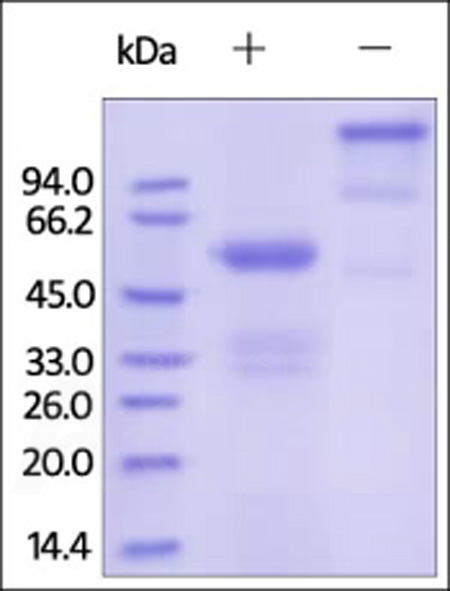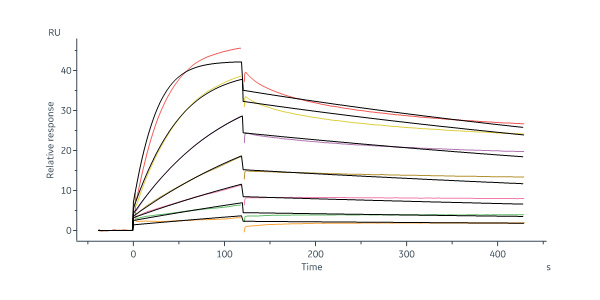分子别名(Synonym)
FGF9,GAF,HBFG-9,MGC119914,MGC119915,SYNS3
表达区间及表达系统(Source)
Human FGF-9, Fc Tag (FG9-H4267) is expressed from human 293 cells (HEK293). It contains AA Leu 4 - Ser 208 (Accession # AAI03979).
Request for sequence
蛋白结构(Molecular Characterization)

This protein carries a human IgG1 Fc tag at the N-terminus.
The protein has a calculated MW of 50.1 kDa. The protein migrates as 55 kDa under reducing (R) condition, and 110 kDa when calibrated against Star Ribbon Pre-stained Protein Marker under non-reducing (NR) condition (SDS-PAGE) due to glycosylation.
内毒素(Endotoxin)
Less than 1.0 EU per μg by the LAL method.
纯度(Purity)
>92% as determined by SDS-PAGE.
制剂(Formulation)
Lyophilized from 0.22 μm filtered solution in 50 mM Tris, 100 mM Glycine, pH7.5 with trehalose as protectant.
Contact us for customized product form or formulation.
重构方法(Reconstitution)
Please see Certificate of Analysis for specific instructions.
For best performance, we strongly recommend you to follow the reconstitution protocol provided in the CoA.
存储(Storage)
For long term storage, the product should be stored at lyophilized state at -20°C or lower.
Please avoid repeated freeze-thaw cycles.
This product is stable after storage at:
- -20°C to -70°C for 12 months in lyophilized state;
- -70°C for 3 months under sterile conditions after reconstitution.
电泳(SDS-PAGE)

Human FGF-9, Fc Tag on SDS-PAGE under reducing (R) and non-reducing (NR) conditions. The gel was stained with Coomassie Blue. The purity of the protein is greater than 92% (With Star Ribbon Pre-stained Protein Marker).
活性(Bioactivity)-SPR

Human FGF R3 (IIIc), Fc Tag (Cat. No. FGC-H5256) immobilized on CM5 Chip can bind Human FGF-9, Fc Tag (Cat. No. FG9-H4267) with an affinity constant of 10.5 nM as determined in a SPR assay (Biacore 8K) (Routinely tested).
Protocol
背景(Background)
Fibroblast growth factor 9 is also known as FGF9, GAF, HBFG-9, SYNS3, and is a member of the fibroblast growth factor (FGF) family. FGF family members possess broad mitogenic and cell survival activities, and are involved in a variety of biological processes, including embryonic development, cell growth, morphogenesis, tissue repair, tumor growth and invasion. FGF9 is also a mitogen for oligodendrocyte type 2 astrocyte progenitor cells, smooth muscle cells, pheochromocytoma PC12 cells, and BALB/3T3 fibroblasts. However, unlike FGF acidic and basic, FGF9 has no effect on human umbilical vein endothelial cells, and it has been demonstrated that FGF9 binds preferentially to the IIIc form of FGFR3. Although no typical signal sequence was found in FGF9, it is secreted efficiently after synthesis not in a conventional manner. In nervous system, FGF9 is produced mainly by neurons and may plays an important role in CNS development. FGF9 has been shown to interact with Fibroblast growth factor receptor 3.























































 膜杰作
膜杰作 Star Staining
Star Staining













